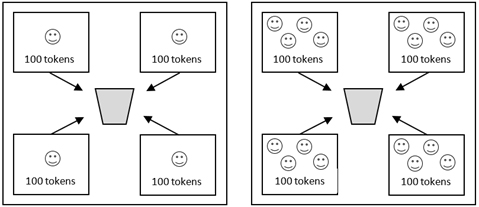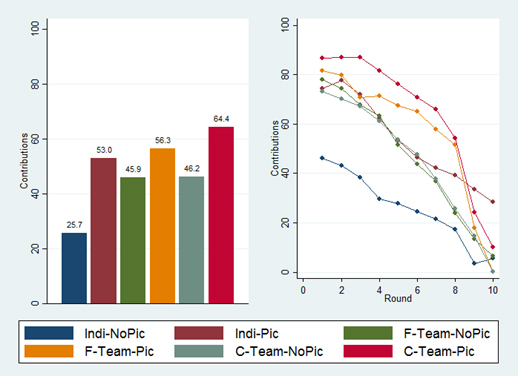“Naming and shaming” of individuals and groups in a public goods experiment

Given people’s aversion to feelings of shame or guilt, increasing transparency can be an effective way to regulate interpersonal relationships. This can even have positive side effects beyond the interpersonal relations, for example, when a change of personal eating or commuting habits due to social pressure has positive effects on the global climate (Nyborg et al., 2016). But does this result also hold for group behavior? Are groups, like individuals, sensitive to the observance and potential disapproval by others? Country rankings or ratings on issues like poverty reduction, political freedom, or environmental performance are published in order to increase countries’ awareness and their motivation to address those issues. Likewise, the Paris Agreement on climate change tries to initiate a process in which countries adopt increasingly ambitious emission reduction goals by improving transparency and identifying the “laggards.” However, so far there is little evidence that these approaches work as intended.
In a new study (Christens, Dannenberg and Sachs, 2017), we have investigated the effects of identification on cooperation among individuals and groups in a controlled experimental setting. This approach allows us to create clear counterfactual situations without identification and to compare the behavioral responses of individuals and groups. Overall, 720 undergraduate students participated in the experiment. The game was an incentivized public goods game which was played by four players that were either individuals or teams consisting of four members (see Figure 1). In ten successive rounds, players had to decide on how much of their endowment of 100 tokens to keep for themselves and how much to contribute to the public good. The social optimum was achieved if all players contributed their full endowment to the public good but each player had an incentive to keep the endowment, creating the classical social dilemma. When the game was played by teams, we considered two types of communication among the team members: they could either discuss face to face or they communicated via computer chat. In both cases, they were asked to discuss and make a consensus decision within five minutes. There was no communication between teams or between individual players when the game was played by individuals.

The left panels shows the public goods game played by individuals. The right panel shows the game played by teams. To have comparable incentives in both settings, the exchange rate between tokens and Euros was 100:1 for individuals and 25:1 for the teams.
We not only varied whether the game was played by individuals or teams but also if it was played anonymously or if players could identify each other. When the game was played anonymously, players could see the contributions by all players on the computer screen after each round but they could not identify each other. With identification, digital photos of the contributors were shown next to the corresponding contribution. The main difference between individuals and teams then of course was that individuals saw only one face on the photo next to a contribution while the teams saw four faces.
Figure 2 provides an overview of the experimental results. The left panel shows the average contributions across all rounds and the right panel shows the average contributions over time. The first two bars in the left panel show the contributions when the game was played by individuals, either anonymously (Indi-NoPic) or with identification (Indi-Pic). We see that, when identities are revealed, players on average contribute more than twice as much than when identities are kept private. The right panel shows that the difference between Indi-NoPic and Indi-Pic exists in the first round already and remains relatively stable throughout the game. The other bars in the left panel of Figure 2 show the average contributions of the teams. F-Teams are the teams that communicated face to face and C-Teams are the teams that communicated via computer chat. NoPic and Pic indicate again whether the game was played anonymously or not. It is easy to see that teams contribute more on average than individuals. More importantly, however, the results show that identification has a much smaller effect on teams than on individuals and indeed the differences between F-Team-NoPic and F-Team-Pic and between C-Team-NoPic and C-Team-Pic are not statistically significant. As can be seen in the right panel, in the last round of the game, there is almost no difference between the anonymous teams and the identified teams.

Figure 2. Average contributions to the public good by treatment
The left panel shows average contributions across all rounds by treatment. The right panels shows average contributions over time by treatment. The number of observations for each treatment is N = 10.
Thus, while the disclosure of identities has an immediate and lasting effect on individuals, the effect on teams is relatively small and only temporary. The reason for this difference between individuals and groups arguably is that members of a group share the responsibility for a decision, they do not feel singled out for doing something inappropriate, and they can support and convince each other that they have made an appropriate decision for which there is no need to feel shame or guilt. This opportunity does not exist for an individual decision maker. To get a better understanding of these processes, we examined how the players’ sensitivity to others’ opinions affects their behavior. To this end, before the participants learned about they game, they were asked how much they care about what other people think about them. Using this information in a regression analysis, we find that sensitivity to others’ opinions has a significant effect on individuals whose identities are revealed but it has no significant effect on individuals whose identities remain private. Moreoever, there is no significant effect on teams irrespective of whether their identities are revealed or not. Thus, being in a team appears to help subjects to overcome their concerns about other people’s opinions. This happens not only because highly sensitive subjects are matched with less sensitive subjects but also because sensitive subjects become less sensitive when they are part of a team.
Taken together, our study confirms that identification can improve cooperation among individuals, but it also shows that identification has not the same effect on groups as it has for individuals. We conclude from this that concern about others’ disapproval belongs to models of individual behavior but not group behavior. “Naming and shaming” alone may not be enough to motivate groups or entire countries to change their behavior. Group interactions seem to require stronger regulations at least when the responsibility for decisions is diffused and members can hide within the group which probably is the case for most group decisions. Even though transparency in the provision of global public goods is a value of its own, climate and other negotiators are well advised to not rely on “naming and shaming” alone.
References
Andreoni, J., Petrie, R., 2004. Public goods experiments without confidentiality: A glimpse into fund-raising. Journal of Public Economics 88 (7-8), 1605–1623.
Christens, S., Dannenberg, A., Sachs, F., 2017 Identification of individuals and groups in a public goods experiment. MAGKS Joint Discussion Paper Series in Economics 55-2017, 1-35 (https://www.uni-marburg.de/fb02/makro/forschung/magkspapers/paper_2017/55-2017_christens.pdf).
Kraft-Todd, G., Yoeli, E., Bhanot, S., Rand, D.G., 2015. Promoting Cooperation in the Field. Current Opinion in Behavioral Sciences 3, 96-101.
Nyborg, K. et al., 2016. Social Norms as Solutions. Science 354 (6308) 42-43.
Rand, D.G., Yoeli E., Hoffman, M., 2014. Harnessing Reciprocity to Promote Cooperation and the Provision of Public Goods. Policy Insights from the Behavioral and Brain Sciences 1(1), 263-269.
Rege, M., Telle, K., 2004. The impact of social approval and framing on cooperation in public good situations. Journal of Public Economics 88 (7-8), 1625–1644.
Samek, A.S., Sheremeta, R.M., 2014. Recognizing Contributors: An Experiment on Public Goods. Experimental Economics 17 (4), 673–690.
About the Authors

Sven Christens is a PhD candidate at the University of Kassel. Before this, he obtained his MA in Economics at the Universities of Lyon and Leipzig. His main research interest is in experimental economics, group behavior, and environmental treaties.

Astrid Dannenberg is Professor of Environmental and Behavioral Economics at the University of Kassel. She received her MA in Economics at the University of Mannheim and her PhD at the Otto-von-Guericke-University of Magdeburg. She previously was a Research Fellow at the Centre for European Economic Research in Mannheim, the University of Gothenburg, and Columbia University in New York City. In 2014, she was awarded an ERC Starting Grant by the European Research Council for her research project “Human Cooperation to Protect the Global Commons” (HUCO).
